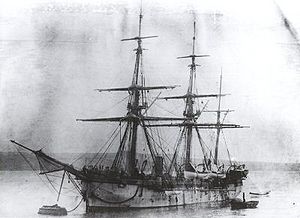HMS Egeria (1873)
 HMS Egeria | |
| Career (United Kingdom) | |
|---|---|
| Name: | HMS Egeria |
| Builder: | Pembroke |
| Cost: | Hull £32,468, machinery £10,414[1] |
| Launched: | 1 November 1873 |
| Fate: | Sold in 1911 |
| General characteristics | |
| Class and type: | Fantome-class Screw Composite Sloop |
| Tons burthen: | 940 tons |
| Length: | 160 ft (49 m) |
| Beam: | 31 ft (9.4 m) |
| Draught: | 14 ft (4.3 m) |
| Propulsion: |
|
| Sail plan: | Barque Rigged |
| Range: | 1,000 nmi (1,900 km) at 10 kn (19 km/h) |
| Complement: | 125 |
| Armament: |
|
HMS Egeria was a 4-gun screw sloop of the Fantome class launched at Pembroke on 1 November 1873[2]. She was named after Egeria, a water nymph of Roman mythology, and was the second ship of the Royal Navy to bear the name.
Contents
Construction
Egeria was constructed of an iron frame sheathed with teak and copper (hence 'composite'), and powered by a two-cylinder horizontal compound-expansion steam engine. This engine, provided by Humphrys, Tennant & Company,[1] drove a single 11-foot (3.4 m) diameter screw and generated an indicated 1,011 horsepower (754 kW). Steam was provided by three cylindrical boilers working at 60 pounds per square inch (4.1 bar).
The Perak War
In 1875 Egeria, commanded by Commander Ralph Lancelot Turton, proceeded to Perak (in modern Malaysia), as one of a squadron of six ships under Captain Alexander Buller with his senior officer’s pennant in HMS Modeste, to take part in an expedition against the murderers of Mr James W. W. Birch, the British Resident in Perak. While the troops and a naval brigade advanced on the upper reaches of the Perak River simultaneously from two points, Egeria blockaded the Perak Littoral, and sent her boats up the Kurow River. These boats destroyed or carried off some guns, arms, and ammunition which might have been useful to the enemy. Severe punishment was inflicted on the natives, but the murderers were not brought to account for some time afterwards. [3]
Survey of Australia
From 1886, under the command of Captain Pelham Aldrich, Egeria was engaged in survey around Australia.[4]
In 1890 Hansard records that
| “ | One petty officer and one seaman of the Egeria were tried for attempting to make a mutinous assembly and for wilful disobedience to orders, and were sentenced respectively to five years' penal servitude and two years' imprisonment. Five other seamen were tried for disobedience, and sentenced to punishments varying from one year to six months' imprisonment.[5] | ” |
Survey of British Columbia
In 1898, Egeria arrived in British Columbia where she was engaged in coastal surveys for the Royal Navy until 1910, by which time coast surveying responsibilities had been transferred to the Canadian Hydrographic Service. The previous surveying ship, the steamship Beaver, had been paid off 28 years earlier in 1870.
Egeria was primarily involved in resurveying settled areas of the British Columbia coast to create modern charts on a larger scale. The last survey it conducted was of Welcome Pass off the Sunshine Coast of British Columbia. [6]
A representation of Egeria is included on a commemorative tile at the Marine Building at 355 Burrard St. in Vancouver, British Columbia. It is one of eight historic ships of British Columbia so honored by this Art Deco building which opened in 1930.
Decommissioning and sale
After many years in the Surveying Service, in November 1911 she was put up to public auction at Esquimalt, and sold to the Vancouver branch of the Navy League for £1,416.
References
- ↑ 1.0 1.1 1.2 Winfield, Rif; Lyon, David (2003). The Sail and Steam Navy List, 1815-1889. Chatham Publishing. ISBN 978-1861760326.
- ↑ "Naval Sloops at battleships-cruisers.co.uk". http://www.battleships-cruisers.co.uk/naval_sloops_.htm. Retrieved 2008-08-30.
- ↑ "HMS Egeria at Battleships-cruisers.co.uk website". http://www.battleships-cruisers.co.uk/name_histories_e.htm#HMS%20Egeria. Retrieved 2008-08-30.
- ↑ "HMS Egeria at William Loney website". http://www.pdavis.nl/ShowShip.php?id=1385. Retrieved 2008-08-30.
- ↑ "Hansard 24 June 1890". http://hansard.millbanksystems.com/commons/1890/jun/24/hms-egeria. Retrieved 2008-08-30.
- ↑ Little, Gary. "First Chart to Identify Half-Moon Bay Discovered in UK by Gary Little". http://www.garylittle.ca/pr-20060629.html. Retrieved 2009-01-09.
| ||||||||
